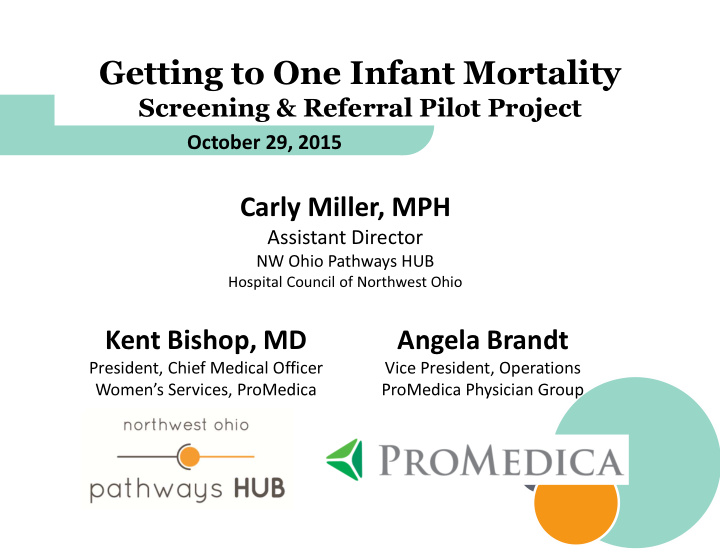



Getting to One Infant Mortality Screening & Referral Pilot Project October 29, 2015 Carly Miller, MPH Assistant Director NW Ohio Pathways HUB Hospital Council of Northwest Ohio Kent Bishop, MD Angela Brandt President, Chief Medical Officer Vice President, Operations Women’s Services, ProMedica ProMedica Physician Group
Getting Started… Infant Mortality Task Force • When was it started? • Why was it started? • What was the goal?
Partnerships with Community Organizations • Co-Leads of Toledo-Lucas County Ohio Equity Institute presented to ProMedica Infant Mortality Task Force • Identified social determinants of health as major preventable cause of infant mortality • Discussions of how to identify and remove social determinants to improve birth outcomes/decrease infant deaths
In collaboration with Getting to One & the Northwest Ohio Pathways HUB, the ProMedica Infant Mortality Task Force created a screening process to identify women at greatest risk for a poor birth outcome and infant death as early as possible.
Screening & Education This screening tool is being used to identify specific, social risk factors that would cause a woman to have a poor birth outcome or cause an infant to die in their first year of life, including: • Insurance status • Access to Care (Food, housing, transportation, childcare, etc.) • Safety & Emotional Health (tobacco, substance use, mental health) Additionally, the assessment discusses important topics such as: • Safe Sleep Education • Birth Control/Safe Spacing • Breastfeeding Benefits & Intention • Progesterone
Screening The Pregnancy Lifestyle Assessment is currently being distributed to all pregnant patients throughout the ProMedica Toledo Metro Region at 3 stages in their pregnancy: 1) The Initial Visit 2) The 28 Week Visit 3) The Postpartum Visit
7
Role of the Referring Office
9
Referral When a woman is identified as having risk factors requiring a referral to community resources, physician offices send a referral to the Northwest Ohio Pathways HUB, who will connect the client to the appropriate resource to remove the identified barrier to care, including home visitation programs: • Pathways • Toledo-Lucas County Healthy Start • Help Me Grow Home Visitation • Early Head Start • Neighborhood Health Association Perinatal Outreach (OIMRI) • Maternal Infant Early Childhood Home Visitation (MIECHV)
Outcomes April 1- September 30, 2015
Referrals From April 1- September 30, 2015 approximately 1826 questionnaires were completed. Of the 1826, 330 (18%) were referred to the Pathways HUB.
Identified Patient Needs N= 330 Top Reasons for Referral
Patient Demographics Referrals by Age of Mother Referrals by Race/Ethnicity 2 2 7 1% 1% 2% 19 52 28 6% 11-14 16% 8% Asian 15-19 Other * 121 Hispanic/Latino 161 20-24 141 107 39% 52% 43% 32% Black/AA 25-34 White/Caucasian 35-44 • The median age for referred clients was 25 • 52% of clients identified as Caucasian, 39% African American, 6% Hispanic
Insurance Status 5% 9% Medicaid Private Uninsured 86%
Referral by Geographic Area Referrals Received by Zip Code 40 34 35 32 30 25 24 23 25 19 19 19 20 16 15 14 15 10 5 0 43612 43605 43615 43606 43608 43613 43609 43607 43611 43604 43623
Referral Outcomes N= 330 Referral not Referred Out eligible 33 25 Total Pending 10% 8% 20 6% Unable to be contacted 51 Client Declined Not Enrolled 15% Services 118 57 35% 17% Total Enrollment 134 41% Not enrolled HMG 10 3%
Birth Outcomes April 1- October 25, 2015 Total Number of Births 29 (including 1 set of twins) 20 Healthy Birth Weight (excluding twins) Low Birth Weight (excluding twins) 6 Preterm Deliveries 6 Infant Death 1 (congenital defect- referred for supportive services) Twins 34 weeks gestation, 5 lbs. 0 oz., 4 lbs. 9 oz. *At this time, birth outcomes are only able to be collected for clients enrolled into Pathways program
Analysis of Low Birth Weight Births Of the 6 moms who delivered babies born Low Birth Weight… • 5 were African American • 3 resided in 43608 zip code • 5 were referred at 28 weeks (3 rd Trimester), 1 referred at initial • Average length of time in Pathways program was 7 weeks Top Indicated Reasons for Referral: • Food (3/6) • Housing (3/6) • Mental Health (3/6) • Transportation (3/6) • Tobacco Use (2/6) • Substance Use (2/6)
Additional Outcomes How it’s Measured Attended Eligible Postpartum Appointment attended 21-56 days after 9 11 Appointment delivery Well Baby Visit Attendance of visit w/ pediatrician 27 28 Reliable Family Family planning method selected and in 5 11 Planning Method place at postpartum appointment Breastfeeding Mother breastfeeding at postpartum 5 10
Success Story Meet Kristin • 31 years old, Caucasian • Referred to the HUB by her ProMedica provider at 26 weeks for opiate dependence • Connected to a Community Health Worker at Mercy who specializes in opiate addiction in pregnancy • Got her a next day appointment with Substance Abuse Services Inc. (SASI) • Began daily dosing of methadone • Delivered a 6lb., 15 oz., baby at 39 weeks • Baby spent no time in the NICU and went home with mom
Provider’s Perspective
Next Steps • Training and implementation of Pediatric Providers • Implementation of Emergency Departments • Engaging and Implementing other Healthcare Systems • Implementation in WIC offices
Lessons Learned • Collaboration is the key to success • Need to identify a local champion • Need to be flexible- what works in one office may not work in every office
Discussion
Recommend
More recommend